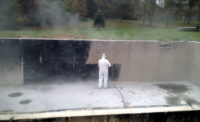The Blasting of Alden Hall: A Case Study
The first call about Alden Hall came last summer. Jeff Sweat, the second-generation owner of Jim Davis Restoration Services of Terre Haute, Ind., had been brought to the project because of his hard-earned reputation for meeting or exceeding expectations.

The first call about Alden Hall came last summer. Jeff Sweat, the second-generation owner of Jim Davis Restoration Services of Terre Haute, Ind., had been brought to the project because of his hard-earned reputation for meeting or exceeding expectations. While it was this reputation that got him the invitation, his capabilities won him the bid. But might this job be beyond his expertise?

Image 1

Image 2
As happens with so many public institutions without funding, the buildings were boarded-up and closed to occupants. For the next decade the campus sat idle. The buildings began to fall into disrepair, with the only verifiable inhabitants being bats, raccoons and other small interlopers (Image 2). But like so many boarded-up and abandoned buildings, the place developed a reputation for housing a few earth-bound spirits.

Image 3
In the summer of 1987 the Pi Kappa Alpha fraternity, newly formed on the campus of nearby Rose-Hulman University, needed a place to call home. They formed a “housing corporation” with the purpose of finding suitable residences for members of the fraternity. The “Pikes” leased the entire 26 acres and its buildings with the intention of residing in the former administration building. In 1993 the housing corporation purchased the entire campus.

Image 4
It was also around then that a Pi Kappa Alpha named Tim “T.O.” Orr, at the time a sophomore, began to ask questions about the old campus, and in particular about the abandoned structures.

Image 5

Image 6
This much the contractor knew. What he didn’t know was how to restore certain areas of the brick structure to a condition considered “restored.”

Image 7
Initially contacted for the job of cleaning brick with baking soda blasting, the subject soon turned to blasting of another sort. The former dormitory was built using a lattice work of exposed steel trusses, joists and beams, now heavily rusted (Images 4, 5 and 6). Although structurally sound, these components would require heavy stripping and a protective coating of paint to avoid further deterioration and, ultimately, structural failure.

Image 8
He need not have worried. With a little additional training and a few new accessories, they were in business.
JDR performed approximately $22,000 worth of blasting and related services on the Alden Hall project. The company was able to provide not only baking soda blasting for the delicate brick and mortar cleaning, but also abrasive blasting for the heavily rusted components.

Image 9

The blasting took a couple of weeks to complete. All told, 5 or 6 different technicians participated in the blasting and related operations like recycling media through the machine, cleaning, and ultimately painting the steel. The contractor, the customer, and the crew were all very happy with the results.

As is Jeff Sweat. Two more nearly identical dorms to Alden Hall sit quietly nearby. Ghosts or no ghosts, he’s anticipating a future full of blasting opportunities.
Looking for a reprint of this article?
From high-res PDFs to custom plaques, order your copy today!




